





Blog
Email marketing strategy

Blog
Email marketing strategy

Blog
Email marketing strategy

Blog
Email marketing strategy
How Personalization Can Drive Sales & Conversions
How Personalization Can Drive Sales & Conversions
How Personalization Can Drive Sales & Conversions
How Personalization Can Drive Sales & Conversions

Shubhangi Kaushik
Apr 23, 2024

Shubhangi Kaushik
Apr 23, 2024

Shubhangi Kaushik
Apr 23, 2024

Shubhangi Kaushik
Apr 23, 2024
Table of Content
>
Title
>
Title
>
Title
>
Title
You know that feeling when you open an email, and it seems like the company understands you?
You feel as if the email was precisely created for you.
That's the power of personalized marketing at work.
In today's crowded marketing landscape, more than ever before, customers crave personalized touch. They want to feel valued and understood as individuals, not just another number in a vast ocean of consumers.
Personalized marketing has become the key to unlocking deeper engagement and driving sales. You can foster long-lasting loyalty with the magic of personal touch.
In this guide, you'll discover the art and science of personalized marketing. Let's delve in and find out how you can leverage it to supercharge your business growth.
What is Personalization?
Personalization is the art of understanding the choices and preferences of each customer. With the help of personalization, you can treat customers in a way they feel understood.
Think back to the days of traditional mass marketing. Brands would broadcast the same generic message to millions of people. The one-size-fits-all approach missed the mark leaving customers feeling disconnected and unengaged.
However, the rise of digital technologies and the availability of customer data has ushered in a new era of personalized marketing. Now, you have the tools and insights to understand your customers at a granular level. Hence, you can craft emails and offers tailored to their specific needs, preferences, and behaviors.
This shift has fundamentally altered customer expectations. They no longer tolerate generic, impersonal experiences. Instead, they demand relevance, convenience, and a deep understanding of who they are as individuals. Brands that fail to deliver personalized touch experiences fall.
Why is Personalization so Important?
Here are a few reasons that underscore the importance of personalization:
1. Increased Revenue
According to McKinsey, businesses that implement personalized marketing strategies can see a revenue uplift of up to 15%.
You can significantly boost conversion rates and sales by delivering highly relevant and targeted messaging.
2. Cost Savings
Personalization can also reduce acquisition costs by up to 50% and increase marketing spending efficiency by 10 to 30%. By focusing your efforts on the most relevant and engaged segments, you can optimize your marketing budget and drive better ROI.
3. Customer Loyalty
Personalized experiences foster deeper connections and loyalty. Epsilon found that 80% of customers are more likely to do business with companies that offer personalized experiences.
4. Impulse Purchases
According to Forbes research, personalization in marketing is desired by 90% of American customers.
Nearly half of all shoppers report making an impulse purchase after receiving a personalized recommendation from a brand.
As you can see personalized marketing is a game-changer for driving engagement, loyalty, and sales.
But how exactly do you implement it effectively? Let's dive into the strategies and tactics that will help you master this powerful approach.
How to build your personalized marketing strategy
Personalized marketing isn’t a one-size-fits-all solution. The key is to tailor your strategy to your business goals and customer segments. Here's a step-by-step guide to building a personalized marketing strategy that delivers results:
1. Define Your Goals
Start by clearly defining your goals for personalized marketing. Do you want to increase sales, drive loyalty, launch a new product, or recover abandoned carts?
Your goals will shape the type of data you collect and the personalization tactics you employ.
2. Gather Data
Personalization relies heavily on data. You need to gather relevant information about your customers such as:
Demographic data
Behavioral data
Psychographic data
Social media data
Geographic data
This data will provide insights into your customers' preferences, behaviors, and interests. Thus, allowing you to create personalized experiences.
Leverage tools like website analytics, and first-party data to unlock insights about your customers. Make sure you have your customer's consent to collect and use their data. Remember, transparency is the key.
3. Segment Your Audience
With your customer data in hand, it's time to segment your audience into distinct groups. These groups have shared characteristics, behaviors, or preferences.
This will allow you to deliver personalized messaging and offers that resonate with each specific segment.
For example, you might segment your audience based on demographics (age, location, income level). Otherwise, you can segment according to purchase history, browsing behavior, or engagement levels.
The more granular your segments, the more tailored and effective your personalization efforts will be.
4. Map the Customer Journey
Personalization isn't just about delivering the right message. It's about providing a seamless experience at every touchpoint along the customer journey.
Map out the key stages of your customer's journey, from awareness to consideration, purchase, and advocacy. Identify opportunities for personalization at each stage, whether it's personalized ads or content.
For example, you can send dynamic product recommendations during the awareness phase. After that, you send tailored post-purchase follow-ups and loyalty program emails.
5. Choose Your Tactics
With your goals, data, segments, and customer journey mapped out, it's time to select the personalization tactics that will drive the best results. Here are a few more tactics to consider:
Personalized emails and push notifications
Dynamic website content and landing pages
Tailored product recommendations
Retargeting ads based on browsing behavior
Personalized offers and discounts
Customized loyalty programs and post-purchase experiences
6. Test, Optimize, and Iterate
Personalized marketing is a one-shot hit or miss. Every segment you create is nothing but a hypothesis that needs to be proven by data. Hence it is an ongoing process of testing, optimizing, and iterating. Continuously monitor your campaigns' performance, gather feedback, and make data-driven adjustments to refine your approach.
Conduct A/B tests to identify the most effective messaging, offers, and channels for each segment. Remember, customer preferences and behaviors can change over time. So, you need to adapt and evolve your personalization strategy accordingly.
Real-World Examples of Personalization
Now that you understand the foundations of personalized marketing. So, let's explore some inspiring real-world examples of brands that have nailed this approach.
1. Amazon
Amazon is the undisputed leader of personalization. From personalized product recommendations based on your browsing and purchase history to tailored homepage displays, Amazon's hyper-personalized experience keeps customers engaged and coming back for more.
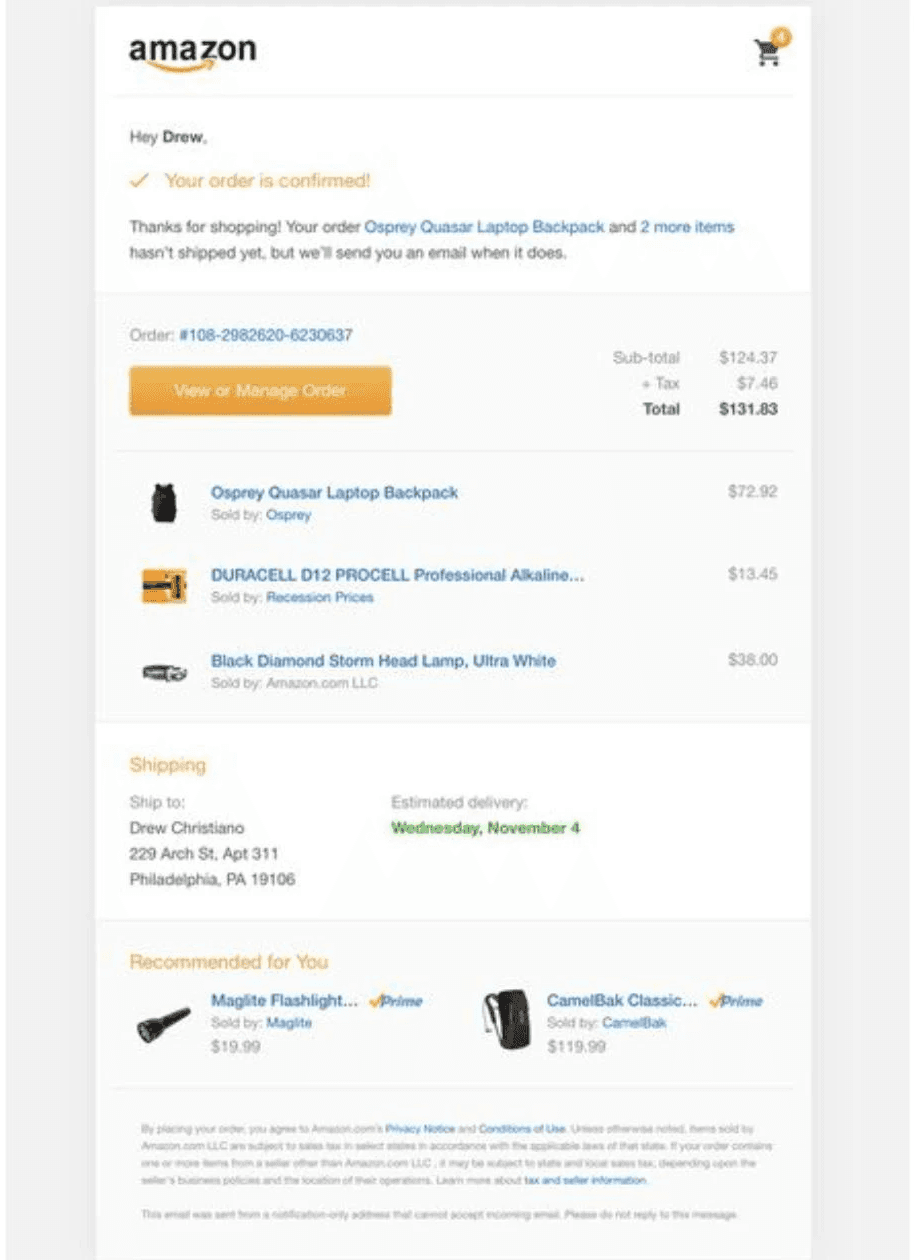
2. Netflix
Netflix is another champion of personalization. It analyzes the shows and movies you watch, rate, and interact with. Hence, serves up a personalized selection tailored to your unique tastes. The platform even calculates a "match percentage" to show how likely you are to enjoy each recommendation.

3. Spotify
Music streaming service Spotify uses personalization to curate custom playlists. The platform delivers personalized music recommendations based on your listening history and preferences. It even predicts the time of day or activity. The "Discover Weekly" playlist is a prime example, introducing you to new artists and songs tailored to your musical tastes.
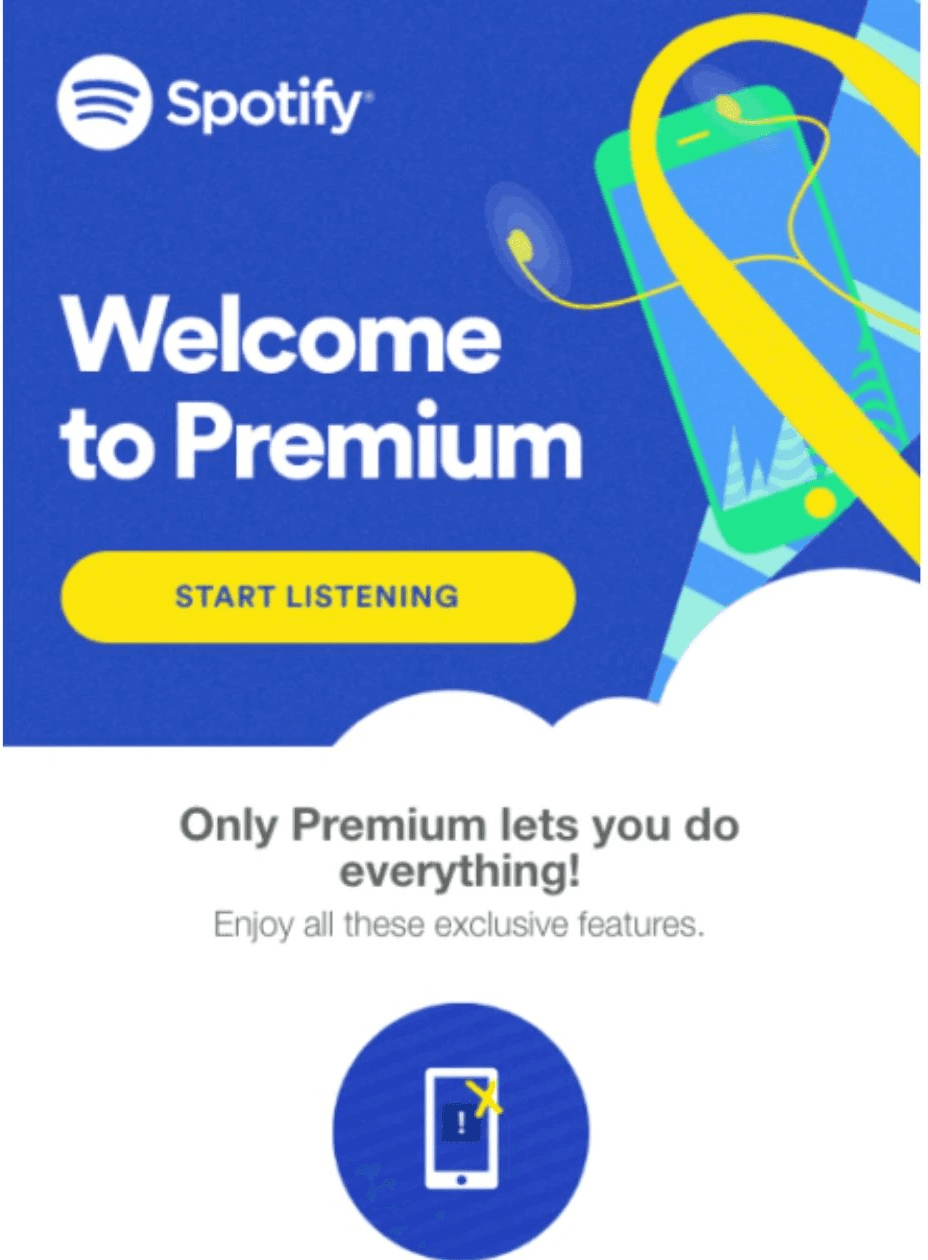
4. Stitch Fix
Stitch Fix is a personal styling service that takes personalization to new heights. After completing a detailed style profile, customers receive a curated box of clothing and accessories handpicked by a personal stylist based on their preferences, body type, and budget.
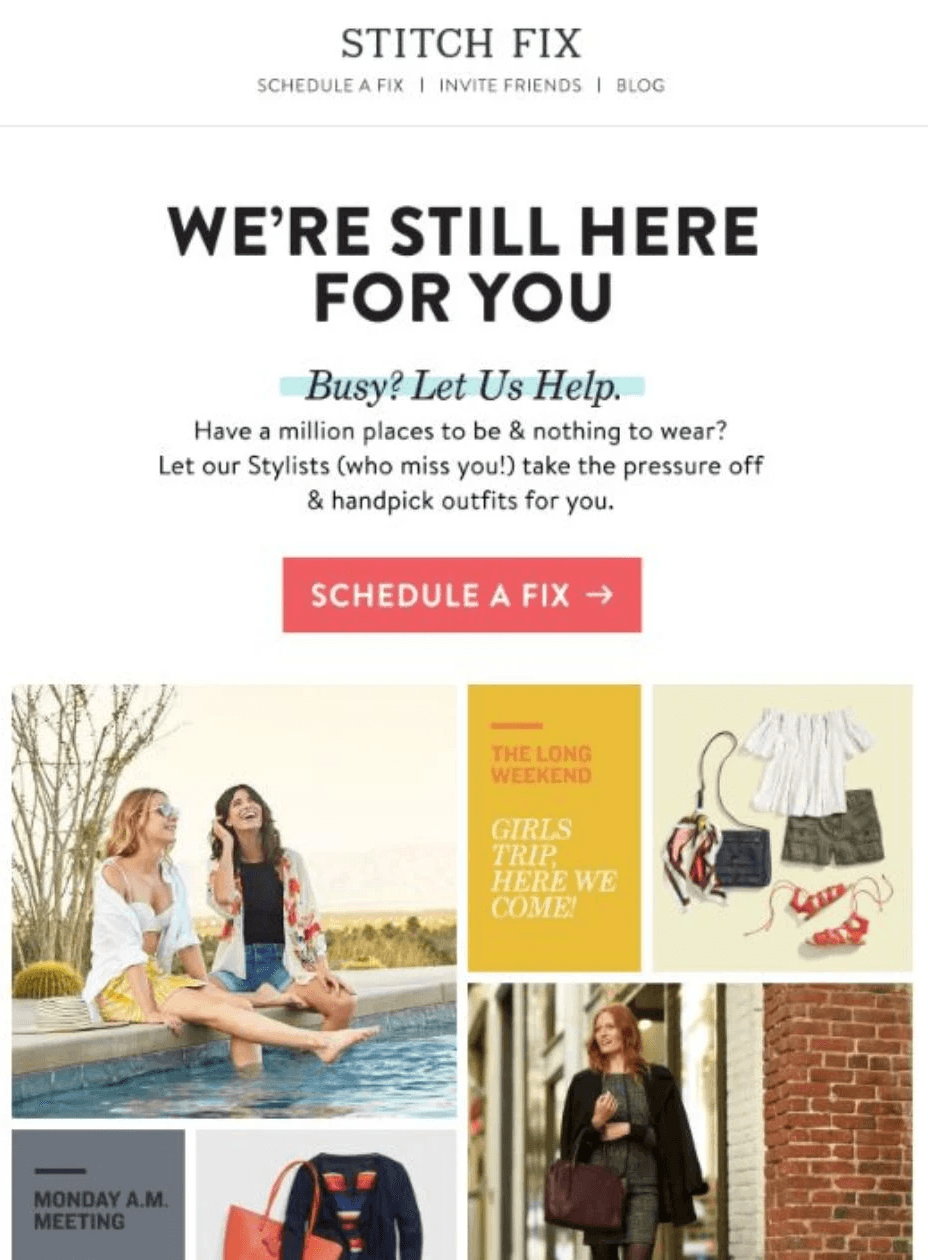
5. Grammarly
Grammarly is a popular writing assistant tool that sends personalized weekly reports to users. This highlights their writing progress, frequent mistakes, and areas for improvement. This tailored feedback helps users better understand and enhance their writing skills.
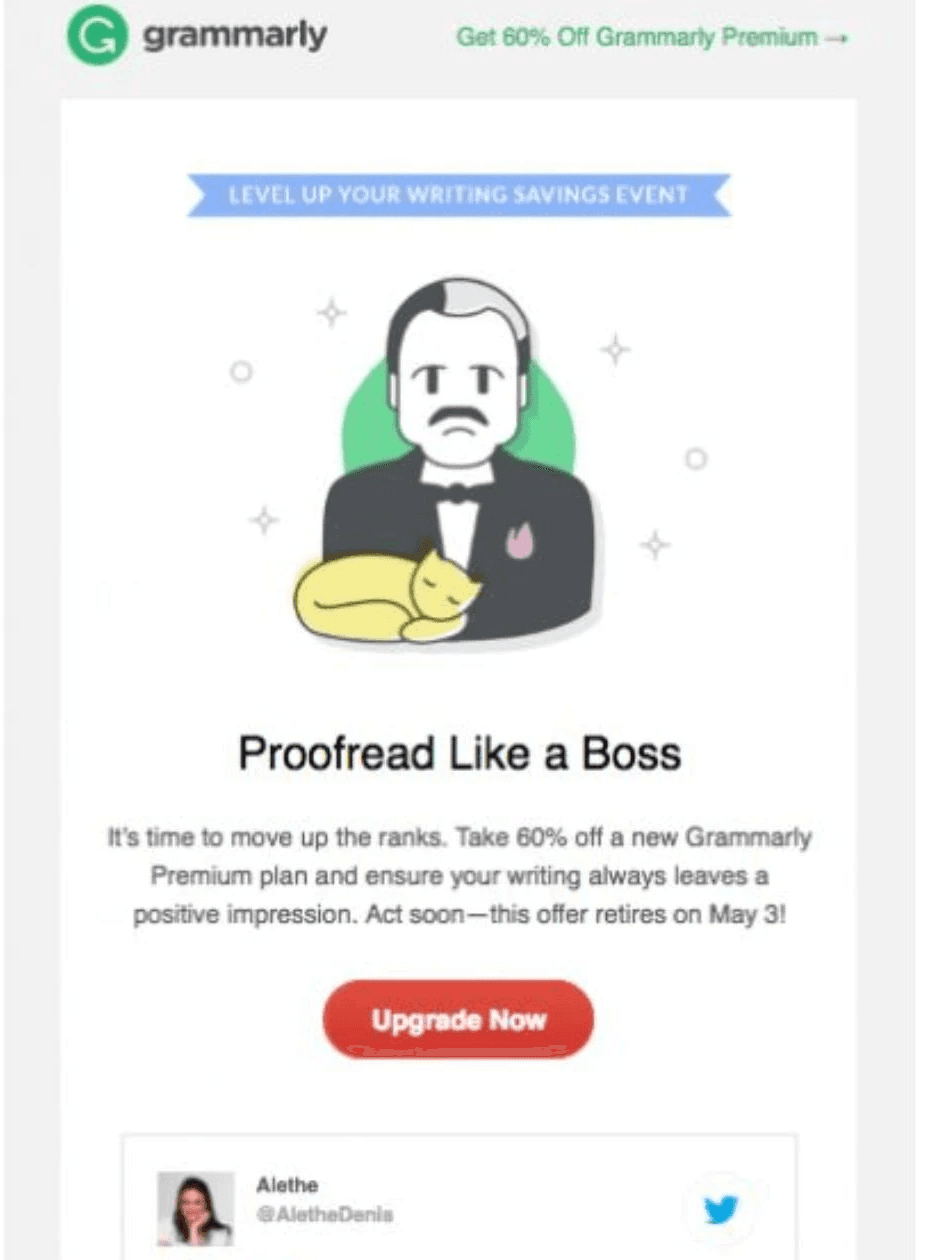
6. ILIA
ILIA recognizes the value of adding a personal touch for its clients. They accomplish this by using strategies like personalized emails. These emails are more than simply advertisements; they also tell you how long things usually last and when to refill favorites. This type of useful information facilitates your buying experience and encourages you to return for more.
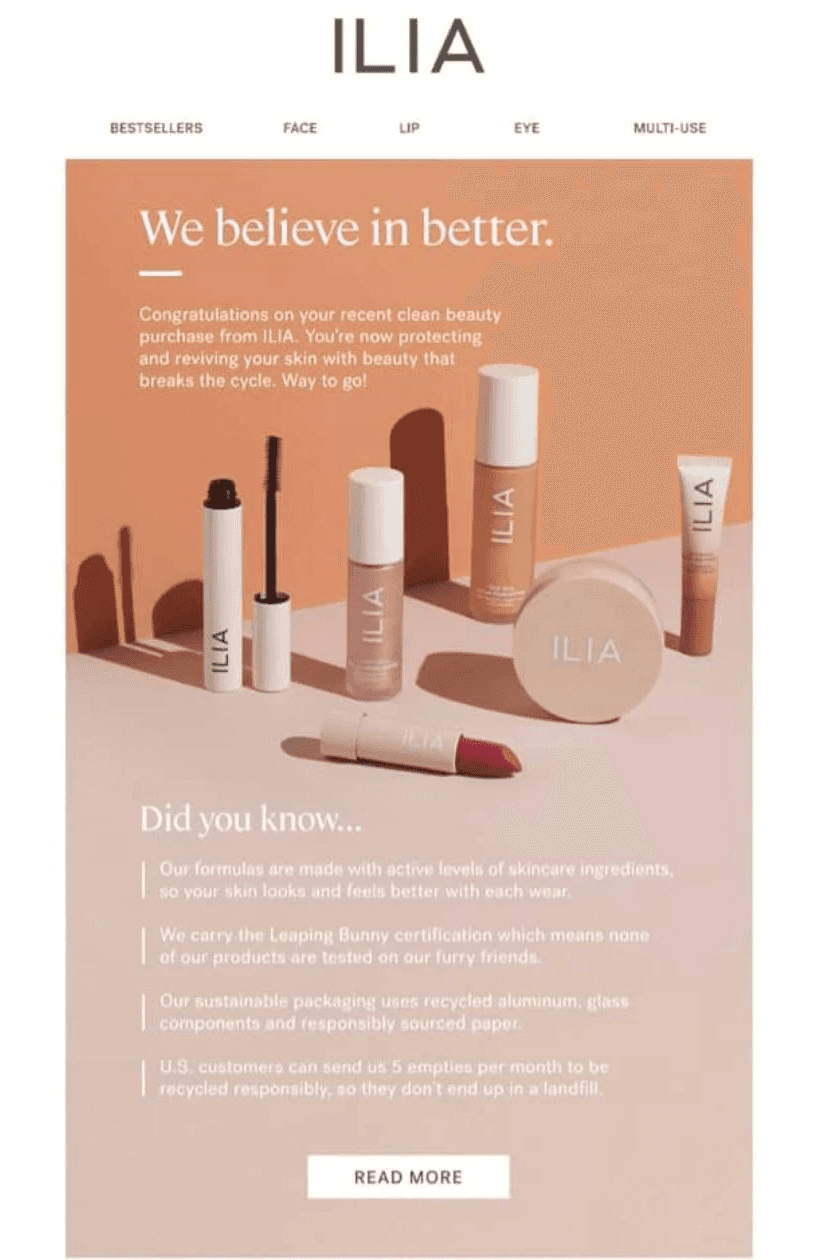
Best Practices for Personalized Marketing
As you embark on your personalized marketing journey, keep these best practices in mind. They can maximize your chances of success:
1. Prioritize Data Privacy and Transparency
With the rise of personalization, there are concerns about data privacy and security. So, we need to be transparent about the data we collect and how we use it. Also, ensure you're complying with all relevant data privacy regulations, such as GDPR and CCPA.
2. Strike the Right Balance
We know personalization can be incredibly powerful. Still, there's a fine line between being helpful and being intrusive. Aim to strike the right balance by providing relevant, valuable experiences without crossing the line.
Don't let your customers feel like you're stalking them or barging their privacy.
3. Maintain Brand Consistency
Personalization should enhance your brand experience, not detract from it. Ensure that your personalized content, messaging, and offers align with your overall brand voice. You can lose the path trying to be overly personal. So, maintain a cohesive and consistent experience across all touchpoints.
4. Continuously Update and Enrich Customer Data
Customer preferences and behaviors are constantly evolving. Hence, it's crucial to regularly update and enrich your customer data. Stale or outdated data can lead to irrelevant personalization efforts and frustrated customers.
5. Leverage Automation and AI
Personalization at scale can be complex and time-consuming. Leverage marketing automation tools and artificial intelligence (AI) technologies to streamline and optimize. This way you'll have enough time and resources to focus on strategy.
Conclusion: Personalization is the future
The brands that invest in personalization capabilities, talent, and culture will ultimately thrive and dominate their market. You can stay ahead of the curve as customers' expectations evolve.
Remember, the key is continuous innovation and a relentless focus on human-centered personalization. This will keep your brand relevant for years to come.
You know that feeling when you open an email, and it seems like the company understands you?
You feel as if the email was precisely created for you.
That's the power of personalized marketing at work.
In today's crowded marketing landscape, more than ever before, customers crave personalized touch. They want to feel valued and understood as individuals, not just another number in a vast ocean of consumers.
Personalized marketing has become the key to unlocking deeper engagement and driving sales. You can foster long-lasting loyalty with the magic of personal touch.
In this guide, you'll discover the art and science of personalized marketing. Let's delve in and find out how you can leverage it to supercharge your business growth.
What is Personalization?
Personalization is the art of understanding the choices and preferences of each customer. With the help of personalization, you can treat customers in a way they feel understood.
Think back to the days of traditional mass marketing. Brands would broadcast the same generic message to millions of people. The one-size-fits-all approach missed the mark leaving customers feeling disconnected and unengaged.
However, the rise of digital technologies and the availability of customer data has ushered in a new era of personalized marketing. Now, you have the tools and insights to understand your customers at a granular level. Hence, you can craft emails and offers tailored to their specific needs, preferences, and behaviors.
This shift has fundamentally altered customer expectations. They no longer tolerate generic, impersonal experiences. Instead, they demand relevance, convenience, and a deep understanding of who they are as individuals. Brands that fail to deliver personalized touch experiences fall.
Why is Personalization so Important?
Here are a few reasons that underscore the importance of personalization:
1. Increased Revenue
According to McKinsey, businesses that implement personalized marketing strategies can see a revenue uplift of up to 15%.
You can significantly boost conversion rates and sales by delivering highly relevant and targeted messaging.
2. Cost Savings
Personalization can also reduce acquisition costs by up to 50% and increase marketing spending efficiency by 10 to 30%. By focusing your efforts on the most relevant and engaged segments, you can optimize your marketing budget and drive better ROI.
3. Customer Loyalty
Personalized experiences foster deeper connections and loyalty. Epsilon found that 80% of customers are more likely to do business with companies that offer personalized experiences.
4. Impulse Purchases
According to Forbes research, personalization in marketing is desired by 90% of American customers.
Nearly half of all shoppers report making an impulse purchase after receiving a personalized recommendation from a brand.
As you can see personalized marketing is a game-changer for driving engagement, loyalty, and sales.
But how exactly do you implement it effectively? Let's dive into the strategies and tactics that will help you master this powerful approach.
How to build your personalized marketing strategy
Personalized marketing isn’t a one-size-fits-all solution. The key is to tailor your strategy to your business goals and customer segments. Here's a step-by-step guide to building a personalized marketing strategy that delivers results:
1. Define Your Goals
Start by clearly defining your goals for personalized marketing. Do you want to increase sales, drive loyalty, launch a new product, or recover abandoned carts?
Your goals will shape the type of data you collect and the personalization tactics you employ.
2. Gather Data
Personalization relies heavily on data. You need to gather relevant information about your customers such as:
Demographic data
Behavioral data
Psychographic data
Social media data
Geographic data
This data will provide insights into your customers' preferences, behaviors, and interests. Thus, allowing you to create personalized experiences.
Leverage tools like website analytics, and first-party data to unlock insights about your customers. Make sure you have your customer's consent to collect and use their data. Remember, transparency is the key.
3. Segment Your Audience
With your customer data in hand, it's time to segment your audience into distinct groups. These groups have shared characteristics, behaviors, or preferences.
This will allow you to deliver personalized messaging and offers that resonate with each specific segment.
For example, you might segment your audience based on demographics (age, location, income level). Otherwise, you can segment according to purchase history, browsing behavior, or engagement levels.
The more granular your segments, the more tailored and effective your personalization efforts will be.
4. Map the Customer Journey
Personalization isn't just about delivering the right message. It's about providing a seamless experience at every touchpoint along the customer journey.
Map out the key stages of your customer's journey, from awareness to consideration, purchase, and advocacy. Identify opportunities for personalization at each stage, whether it's personalized ads or content.
For example, you can send dynamic product recommendations during the awareness phase. After that, you send tailored post-purchase follow-ups and loyalty program emails.
5. Choose Your Tactics
With your goals, data, segments, and customer journey mapped out, it's time to select the personalization tactics that will drive the best results. Here are a few more tactics to consider:
Personalized emails and push notifications
Dynamic website content and landing pages
Tailored product recommendations
Retargeting ads based on browsing behavior
Personalized offers and discounts
Customized loyalty programs and post-purchase experiences
6. Test, Optimize, and Iterate
Personalized marketing is a one-shot hit or miss. Every segment you create is nothing but a hypothesis that needs to be proven by data. Hence it is an ongoing process of testing, optimizing, and iterating. Continuously monitor your campaigns' performance, gather feedback, and make data-driven adjustments to refine your approach.
Conduct A/B tests to identify the most effective messaging, offers, and channels for each segment. Remember, customer preferences and behaviors can change over time. So, you need to adapt and evolve your personalization strategy accordingly.
Real-World Examples of Personalization
Now that you understand the foundations of personalized marketing. So, let's explore some inspiring real-world examples of brands that have nailed this approach.
1. Amazon
Amazon is the undisputed leader of personalization. From personalized product recommendations based on your browsing and purchase history to tailored homepage displays, Amazon's hyper-personalized experience keeps customers engaged and coming back for more.

2. Netflix
Netflix is another champion of personalization. It analyzes the shows and movies you watch, rate, and interact with. Hence, serves up a personalized selection tailored to your unique tastes. The platform even calculates a "match percentage" to show how likely you are to enjoy each recommendation.

3. Spotify
Music streaming service Spotify uses personalization to curate custom playlists. The platform delivers personalized music recommendations based on your listening history and preferences. It even predicts the time of day or activity. The "Discover Weekly" playlist is a prime example, introducing you to new artists and songs tailored to your musical tastes.

4. Stitch Fix
Stitch Fix is a personal styling service that takes personalization to new heights. After completing a detailed style profile, customers receive a curated box of clothing and accessories handpicked by a personal stylist based on their preferences, body type, and budget.

5. Grammarly
Grammarly is a popular writing assistant tool that sends personalized weekly reports to users. This highlights their writing progress, frequent mistakes, and areas for improvement. This tailored feedback helps users better understand and enhance their writing skills.

6. ILIA
ILIA recognizes the value of adding a personal touch for its clients. They accomplish this by using strategies like personalized emails. These emails are more than simply advertisements; they also tell you how long things usually last and when to refill favorites. This type of useful information facilitates your buying experience and encourages you to return for more.

Best Practices for Personalized Marketing
As you embark on your personalized marketing journey, keep these best practices in mind. They can maximize your chances of success:
1. Prioritize Data Privacy and Transparency
With the rise of personalization, there are concerns about data privacy and security. So, we need to be transparent about the data we collect and how we use it. Also, ensure you're complying with all relevant data privacy regulations, such as GDPR and CCPA.
2. Strike the Right Balance
We know personalization can be incredibly powerful. Still, there's a fine line between being helpful and being intrusive. Aim to strike the right balance by providing relevant, valuable experiences without crossing the line.
Don't let your customers feel like you're stalking them or barging their privacy.
3. Maintain Brand Consistency
Personalization should enhance your brand experience, not detract from it. Ensure that your personalized content, messaging, and offers align with your overall brand voice. You can lose the path trying to be overly personal. So, maintain a cohesive and consistent experience across all touchpoints.
4. Continuously Update and Enrich Customer Data
Customer preferences and behaviors are constantly evolving. Hence, it's crucial to regularly update and enrich your customer data. Stale or outdated data can lead to irrelevant personalization efforts and frustrated customers.
5. Leverage Automation and AI
Personalization at scale can be complex and time-consuming. Leverage marketing automation tools and artificial intelligence (AI) technologies to streamline and optimize. This way you'll have enough time and resources to focus on strategy.
Conclusion: Personalization is the future
The brands that invest in personalization capabilities, talent, and culture will ultimately thrive and dominate their market. You can stay ahead of the curve as customers' expectations evolve.
Remember, the key is continuous innovation and a relentless focus on human-centered personalization. This will keep your brand relevant for years to come.
You know that feeling when you open an email, and it seems like the company understands you?
You feel as if the email was precisely created for you.
That's the power of personalized marketing at work.
In today's crowded marketing landscape, more than ever before, customers crave personalized touch. They want to feel valued and understood as individuals, not just another number in a vast ocean of consumers.
Personalized marketing has become the key to unlocking deeper engagement and driving sales. You can foster long-lasting loyalty with the magic of personal touch.
In this guide, you'll discover the art and science of personalized marketing. Let's delve in and find out how you can leverage it to supercharge your business growth.
What is Personalization?
Personalization is the art of understanding the choices and preferences of each customer. With the help of personalization, you can treat customers in a way they feel understood.
Think back to the days of traditional mass marketing. Brands would broadcast the same generic message to millions of people. The one-size-fits-all approach missed the mark leaving customers feeling disconnected and unengaged.
However, the rise of digital technologies and the availability of customer data has ushered in a new era of personalized marketing. Now, you have the tools and insights to understand your customers at a granular level. Hence, you can craft emails and offers tailored to their specific needs, preferences, and behaviors.
This shift has fundamentally altered customer expectations. They no longer tolerate generic, impersonal experiences. Instead, they demand relevance, convenience, and a deep understanding of who they are as individuals. Brands that fail to deliver personalized touch experiences fall.
Why is Personalization so Important?
Here are a few reasons that underscore the importance of personalization:
1. Increased Revenue
According to McKinsey, businesses that implement personalized marketing strategies can see a revenue uplift of up to 15%.
You can significantly boost conversion rates and sales by delivering highly relevant and targeted messaging.
2. Cost Savings
Personalization can also reduce acquisition costs by up to 50% and increase marketing spending efficiency by 10 to 30%. By focusing your efforts on the most relevant and engaged segments, you can optimize your marketing budget and drive better ROI.
3. Customer Loyalty
Personalized experiences foster deeper connections and loyalty. Epsilon found that 80% of customers are more likely to do business with companies that offer personalized experiences.
4. Impulse Purchases
According to Forbes research, personalization in marketing is desired by 90% of American customers.
Nearly half of all shoppers report making an impulse purchase after receiving a personalized recommendation from a brand.
As you can see personalized marketing is a game-changer for driving engagement, loyalty, and sales.
But how exactly do you implement it effectively? Let's dive into the strategies and tactics that will help you master this powerful approach.
How to build your personalized marketing strategy
Personalized marketing isn’t a one-size-fits-all solution. The key is to tailor your strategy to your business goals and customer segments. Here's a step-by-step guide to building a personalized marketing strategy that delivers results:
1. Define Your Goals
Start by clearly defining your goals for personalized marketing. Do you want to increase sales, drive loyalty, launch a new product, or recover abandoned carts?
Your goals will shape the type of data you collect and the personalization tactics you employ.
2. Gather Data
Personalization relies heavily on data. You need to gather relevant information about your customers such as:
Demographic data
Behavioral data
Psychographic data
Social media data
Geographic data
This data will provide insights into your customers' preferences, behaviors, and interests. Thus, allowing you to create personalized experiences.
Leverage tools like website analytics, and first-party data to unlock insights about your customers. Make sure you have your customer's consent to collect and use their data. Remember, transparency is the key.
3. Segment Your Audience
With your customer data in hand, it's time to segment your audience into distinct groups. These groups have shared characteristics, behaviors, or preferences.
This will allow you to deliver personalized messaging and offers that resonate with each specific segment.
For example, you might segment your audience based on demographics (age, location, income level). Otherwise, you can segment according to purchase history, browsing behavior, or engagement levels.
The more granular your segments, the more tailored and effective your personalization efforts will be.
4. Map the Customer Journey
Personalization isn't just about delivering the right message. It's about providing a seamless experience at every touchpoint along the customer journey.
Map out the key stages of your customer's journey, from awareness to consideration, purchase, and advocacy. Identify opportunities for personalization at each stage, whether it's personalized ads or content.
For example, you can send dynamic product recommendations during the awareness phase. After that, you send tailored post-purchase follow-ups and loyalty program emails.
5. Choose Your Tactics
With your goals, data, segments, and customer journey mapped out, it's time to select the personalization tactics that will drive the best results. Here are a few more tactics to consider:
Personalized emails and push notifications
Dynamic website content and landing pages
Tailored product recommendations
Retargeting ads based on browsing behavior
Personalized offers and discounts
Customized loyalty programs and post-purchase experiences
6. Test, Optimize, and Iterate
Personalized marketing is a one-shot hit or miss. Every segment you create is nothing but a hypothesis that needs to be proven by data. Hence it is an ongoing process of testing, optimizing, and iterating. Continuously monitor your campaigns' performance, gather feedback, and make data-driven adjustments to refine your approach.
Conduct A/B tests to identify the most effective messaging, offers, and channels for each segment. Remember, customer preferences and behaviors can change over time. So, you need to adapt and evolve your personalization strategy accordingly.
Real-World Examples of Personalization
Now that you understand the foundations of personalized marketing. So, let's explore some inspiring real-world examples of brands that have nailed this approach.
1. Amazon
Amazon is the undisputed leader of personalization. From personalized product recommendations based on your browsing and purchase history to tailored homepage displays, Amazon's hyper-personalized experience keeps customers engaged and coming back for more.

2. Netflix
Netflix is another champion of personalization. It analyzes the shows and movies you watch, rate, and interact with. Hence, serves up a personalized selection tailored to your unique tastes. The platform even calculates a "match percentage" to show how likely you are to enjoy each recommendation.

3. Spotify
Music streaming service Spotify uses personalization to curate custom playlists. The platform delivers personalized music recommendations based on your listening history and preferences. It even predicts the time of day or activity. The "Discover Weekly" playlist is a prime example, introducing you to new artists and songs tailored to your musical tastes.

4. Stitch Fix
Stitch Fix is a personal styling service that takes personalization to new heights. After completing a detailed style profile, customers receive a curated box of clothing and accessories handpicked by a personal stylist based on their preferences, body type, and budget.

5. Grammarly
Grammarly is a popular writing assistant tool that sends personalized weekly reports to users. This highlights their writing progress, frequent mistakes, and areas for improvement. This tailored feedback helps users better understand and enhance their writing skills.

6. ILIA
ILIA recognizes the value of adding a personal touch for its clients. They accomplish this by using strategies like personalized emails. These emails are more than simply advertisements; they also tell you how long things usually last and when to refill favorites. This type of useful information facilitates your buying experience and encourages you to return for more.

Best Practices for Personalized Marketing
As you embark on your personalized marketing journey, keep these best practices in mind. They can maximize your chances of success:
1. Prioritize Data Privacy and Transparency
With the rise of personalization, there are concerns about data privacy and security. So, we need to be transparent about the data we collect and how we use it. Also, ensure you're complying with all relevant data privacy regulations, such as GDPR and CCPA.
2. Strike the Right Balance
We know personalization can be incredibly powerful. Still, there's a fine line between being helpful and being intrusive. Aim to strike the right balance by providing relevant, valuable experiences without crossing the line.
Don't let your customers feel like you're stalking them or barging their privacy.
3. Maintain Brand Consistency
Personalization should enhance your brand experience, not detract from it. Ensure that your personalized content, messaging, and offers align with your overall brand voice. You can lose the path trying to be overly personal. So, maintain a cohesive and consistent experience across all touchpoints.
4. Continuously Update and Enrich Customer Data
Customer preferences and behaviors are constantly evolving. Hence, it's crucial to regularly update and enrich your customer data. Stale or outdated data can lead to irrelevant personalization efforts and frustrated customers.
5. Leverage Automation and AI
Personalization at scale can be complex and time-consuming. Leverage marketing automation tools and artificial intelligence (AI) technologies to streamline and optimize. This way you'll have enough time and resources to focus on strategy.
Conclusion: Personalization is the future
The brands that invest in personalization capabilities, talent, and culture will ultimately thrive and dominate their market. You can stay ahead of the curve as customers' expectations evolve.
Remember, the key is continuous innovation and a relentless focus on human-centered personalization. This will keep your brand relevant for years to come.
You know that feeling when you open an email, and it seems like the company understands you?
You feel as if the email was precisely created for you.
That's the power of personalized marketing at work.
In today's crowded marketing landscape, more than ever before, customers crave personalized touch. They want to feel valued and understood as individuals, not just another number in a vast ocean of consumers.
Personalized marketing has become the key to unlocking deeper engagement and driving sales. You can foster long-lasting loyalty with the magic of personal touch.
In this guide, you'll discover the art and science of personalized marketing. Let's delve in and find out how you can leverage it to supercharge your business growth.
What is Personalization?
Personalization is the art of understanding the choices and preferences of each customer. With the help of personalization, you can treat customers in a way they feel understood.
Think back to the days of traditional mass marketing. Brands would broadcast the same generic message to millions of people. The one-size-fits-all approach missed the mark leaving customers feeling disconnected and unengaged.
However, the rise of digital technologies and the availability of customer data has ushered in a new era of personalized marketing. Now, you have the tools and insights to understand your customers at a granular level. Hence, you can craft emails and offers tailored to their specific needs, preferences, and behaviors.
This shift has fundamentally altered customer expectations. They no longer tolerate generic, impersonal experiences. Instead, they demand relevance, convenience, and a deep understanding of who they are as individuals. Brands that fail to deliver personalized touch experiences fall.
Why is Personalization so Important?
Here are a few reasons that underscore the importance of personalization:
1. Increased Revenue
According to McKinsey, businesses that implement personalized marketing strategies can see a revenue uplift of up to 15%.
You can significantly boost conversion rates and sales by delivering highly relevant and targeted messaging.
2. Cost Savings
Personalization can also reduce acquisition costs by up to 50% and increase marketing spending efficiency by 10 to 30%. By focusing your efforts on the most relevant and engaged segments, you can optimize your marketing budget and drive better ROI.
3. Customer Loyalty
Personalized experiences foster deeper connections and loyalty. Epsilon found that 80% of customers are more likely to do business with companies that offer personalized experiences.
4. Impulse Purchases
According to Forbes research, personalization in marketing is desired by 90% of American customers.
Nearly half of all shoppers report making an impulse purchase after receiving a personalized recommendation from a brand.
As you can see personalized marketing is a game-changer for driving engagement, loyalty, and sales.
But how exactly do you implement it effectively? Let's dive into the strategies and tactics that will help you master this powerful approach.
How to build your personalized marketing strategy
Personalized marketing isn’t a one-size-fits-all solution. The key is to tailor your strategy to your business goals and customer segments. Here's a step-by-step guide to building a personalized marketing strategy that delivers results:
1. Define Your Goals
Start by clearly defining your goals for personalized marketing. Do you want to increase sales, drive loyalty, launch a new product, or recover abandoned carts?
Your goals will shape the type of data you collect and the personalization tactics you employ.
2. Gather Data
Personalization relies heavily on data. You need to gather relevant information about your customers such as:
Demographic data
Behavioral data
Psychographic data
Social media data
Geographic data
This data will provide insights into your customers' preferences, behaviors, and interests. Thus, allowing you to create personalized experiences.
Leverage tools like website analytics, and first-party data to unlock insights about your customers. Make sure you have your customer's consent to collect and use their data. Remember, transparency is the key.
3. Segment Your Audience
With your customer data in hand, it's time to segment your audience into distinct groups. These groups have shared characteristics, behaviors, or preferences.
This will allow you to deliver personalized messaging and offers that resonate with each specific segment.
For example, you might segment your audience based on demographics (age, location, income level). Otherwise, you can segment according to purchase history, browsing behavior, or engagement levels.
The more granular your segments, the more tailored and effective your personalization efforts will be.
4. Map the Customer Journey
Personalization isn't just about delivering the right message. It's about providing a seamless experience at every touchpoint along the customer journey.
Map out the key stages of your customer's journey, from awareness to consideration, purchase, and advocacy. Identify opportunities for personalization at each stage, whether it's personalized ads or content.
For example, you can send dynamic product recommendations during the awareness phase. After that, you send tailored post-purchase follow-ups and loyalty program emails.
5. Choose Your Tactics
With your goals, data, segments, and customer journey mapped out, it's time to select the personalization tactics that will drive the best results. Here are a few more tactics to consider:
Personalized emails and push notifications
Dynamic website content and landing pages
Tailored product recommendations
Retargeting ads based on browsing behavior
Personalized offers and discounts
Customized loyalty programs and post-purchase experiences
6. Test, Optimize, and Iterate
Personalized marketing is a one-shot hit or miss. Every segment you create is nothing but a hypothesis that needs to be proven by data. Hence it is an ongoing process of testing, optimizing, and iterating. Continuously monitor your campaigns' performance, gather feedback, and make data-driven adjustments to refine your approach.
Conduct A/B tests to identify the most effective messaging, offers, and channels for each segment. Remember, customer preferences and behaviors can change over time. So, you need to adapt and evolve your personalization strategy accordingly.
Real-World Examples of Personalization
Now that you understand the foundations of personalized marketing. So, let's explore some inspiring real-world examples of brands that have nailed this approach.
1. Amazon
Amazon is the undisputed leader of personalization. From personalized product recommendations based on your browsing and purchase history to tailored homepage displays, Amazon's hyper-personalized experience keeps customers engaged and coming back for more.

2. Netflix
Netflix is another champion of personalization. It analyzes the shows and movies you watch, rate, and interact with. Hence, serves up a personalized selection tailored to your unique tastes. The platform even calculates a "match percentage" to show how likely you are to enjoy each recommendation.

3. Spotify
Music streaming service Spotify uses personalization to curate custom playlists. The platform delivers personalized music recommendations based on your listening history and preferences. It even predicts the time of day or activity. The "Discover Weekly" playlist is a prime example, introducing you to new artists and songs tailored to your musical tastes.

4. Stitch Fix
Stitch Fix is a personal styling service that takes personalization to new heights. After completing a detailed style profile, customers receive a curated box of clothing and accessories handpicked by a personal stylist based on their preferences, body type, and budget.

5. Grammarly
Grammarly is a popular writing assistant tool that sends personalized weekly reports to users. This highlights their writing progress, frequent mistakes, and areas for improvement. This tailored feedback helps users better understand and enhance their writing skills.

6. ILIA
ILIA recognizes the value of adding a personal touch for its clients. They accomplish this by using strategies like personalized emails. These emails are more than simply advertisements; they also tell you how long things usually last and when to refill favorites. This type of useful information facilitates your buying experience and encourages you to return for more.

Best Practices for Personalized Marketing
As you embark on your personalized marketing journey, keep these best practices in mind. They can maximize your chances of success:
1. Prioritize Data Privacy and Transparency
With the rise of personalization, there are concerns about data privacy and security. So, we need to be transparent about the data we collect and how we use it. Also, ensure you're complying with all relevant data privacy regulations, such as GDPR and CCPA.
2. Strike the Right Balance
We know personalization can be incredibly powerful. Still, there's a fine line between being helpful and being intrusive. Aim to strike the right balance by providing relevant, valuable experiences without crossing the line.
Don't let your customers feel like you're stalking them or barging their privacy.
3. Maintain Brand Consistency
Personalization should enhance your brand experience, not detract from it. Ensure that your personalized content, messaging, and offers align with your overall brand voice. You can lose the path trying to be overly personal. So, maintain a cohesive and consistent experience across all touchpoints.
4. Continuously Update and Enrich Customer Data
Customer preferences and behaviors are constantly evolving. Hence, it's crucial to regularly update and enrich your customer data. Stale or outdated data can lead to irrelevant personalization efforts and frustrated customers.
5. Leverage Automation and AI
Personalization at scale can be complex and time-consuming. Leverage marketing automation tools and artificial intelligence (AI) technologies to streamline and optimize. This way you'll have enough time and resources to focus on strategy.
Conclusion: Personalization is the future
The brands that invest in personalization capabilities, talent, and culture will ultimately thrive and dominate their market. You can stay ahead of the curve as customers' expectations evolve.
Remember, the key is continuous innovation and a relentless focus on human-centered personalization. This will keep your brand relevant for years to come.
More to Explore
More to Explore
Ready to find out how we can help you achieve 20-30% revenue growth with email marketing?
Ready to find out how we can help you achieve 20-30% revenue growth with email marketing?
Ready to find out how we can help you achieve 20-30% revenue growth with email marketing?
12th floor, Shivarth The Ace, Karma Workspaces, Sindhubhavan Rd, Ahmedabad, Gujarat 380054
2727 Bee Cave Rd, Suite 180, Austin, TX 78746

support@copypowermedia.com
12th floor, Shivarth The Ace, Karma Workspaces, Sindhubhavan Rd, Ahmedabad, Gujarat 380054
2727 Bee Cave Rd, Suite 180, Austin, TX 78746

support@copypowermedia.com
12th floor, Shivarth The Ace, Karma Workspaces, Sindhubhavan Rd, Ahmedabad, Gujarat 380054
2727 Bee Cave Rd, Suite 180, Austin, TX 78746

support@copypowermedia.com



